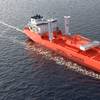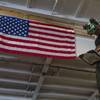British Columbia's fast ferries may be too fast for their own good, according to CANOE columnist Jim Hume. The British Columbia Ferry Corporation first sailed The Explorer on June 17, 1999, with regular service from Vancouver Island (Nanaimo) to Mainland (Horseshoe Bay) starting July 1. While the fast-cats can operate faster than traditional ferries, they are currently only shaving off 14 minutes of their scheduled run, not the 25 minutes promised.
It turns out when the fast boat operates at top speeds in the confined waters of its scheduled route, it raises six-ft. waves along the shore.
Additionally, high-speed fast ferry Snohomish, built by Dakota Creek Industries, Inc. of Anacortes, Wash., was launched on July 13, and is expected to be in service on the Seattle-Bremerton route in September.
Landowners on the narrow passage south of Bainbridge Island, however, contend Chinook's wake (the state's first high-speed fast ferry, which entered service in May, 1998) erodes their beaches, and say they fear Snohomish will, too.
The ferry system maintains tides, storms and waterfront bulkhead designs are responsible for beach erosion. But property owners on Rich Passage have started a three-day court hearing to try to cut speeds of the two ships by two-thirds in hopes of reducing their wakes. From lessons learned on Chinook, changes have been made in the design of Snohomish that should make the ship more versatile, but officials won't predict if these changes will affect its wake. Depending on the outcome of the court hearings, the boats may have to be moved to either the Kingston-Seattle or Southworth-Seattle routes, where the waves will have less effect on the shoreline.
The two-year budget for the Washington State Ferries system approved in the spring by the state Legislature will create a modern fleet of passenger-only ferries and terminals to help move more people across Puget Sound. But the new spending plan also represents a significant investment in two other key areas: renovating older terminals and expanding safety programs throughout the fleet.
The budget is broken down into two areas: the $303 million operating budget, which covers the day-to-day operations at WSF, and the $287 million capital budget, which addresses construction needs. In the capital budget, $116 million came from voter-approved Referendum 49 funds.
"On the operations side, the budget represents a major investment in the operations infrastructure at WSF," said Terry McCarthy, WSF deputy director. "There's a lot of catching up to do on the operating side in terms of training and the infrastructure needed to operate the ferry system. The Legislature responded to that need."
And on the capital side, lawmakers endorsed the passenger-only program that began with the building of Chinook, now in service, and Snohomish, due out this fall. "There's a huge commitment to passenger-only," said McCarthy. "And there's a recognition, as well, that we have to start preserving our older terminals."
Highlights of the new budget include:
International Safety Management (ISM) expansion: ISM is a safety program implemented on the international ferries operating between Anacortes and Sidney, B.C. Under ISM, detailed manuals are created for each vessel and route, covering all aspects of safety and operation. The program adds consistency to all procedures, focusing on safety and emergency response. Now, this program will be applied to the rest of the fleet.
Expanded training: As the ferry system modernizes, new training needs arise. For example, conducting maintenance on a new Jumbo Mark II ferry, which is largely run by computer systems, is radically different from working on a 1920s-era Steel Electric vessel.
Also, new safety equipment, such as heart defibrillators, is being introduced on the ferries.
Terminal preservation projects: The Legislature approved $18 million to repair and modernize aging terminals throughout the system. Many of the old creosote pilings supporting docks and the in-water timber wingwalls are nearing the end of their usefulness. The ferry system has already started replacing some of them with new steel wingwalls and pilings. Now, that program will expand.
Passenger-only terminals: The budget includes funds for new facilities at Kingston, Southworth and Seattle by 2001. WSF terminal engineers are working on design and permits for these projects.
New passenger-only vessels: Five more will be built, to go along with Chinook and Snohomish and the older passenger ferries in the fleet. The ferry system hopes to choose a builder by December. The first passenger-only ferry will take about a year to build and bring into service.
The Legislature also approved $1.5 million for a feasibility study of the Millennium Class - a future class of auto ferries. However, Governor Gary Locke vetoed this expenditure, instructing the ferry system to focus instead on passenger-only ferries and bringing aging docks up to date.
Sponsored Content
Lower carbon intensity fuels to support your operations

Subscribe for
Maritime Reporter E-News
Maritime Reporter E-News is the maritime industry's largest circulation and most authoritative ENews Service, delivered to your Email five times per week










